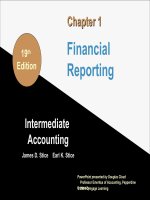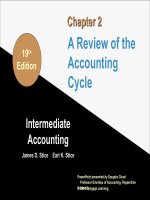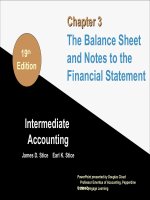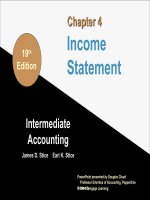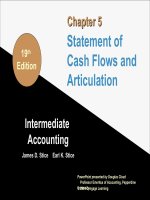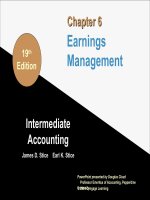Intermediate accounting 19th by stice stice chapter 07
Bạn đang xem bản rút gọn của tài liệu. Xem và tải ngay bản đầy đủ của tài liệu tại đây (211.37 KB, 75 trang )
19th
Edition
Chapter 7
The
Revenue/Receivable/
Cash Cycle
Intermediate
Accounting
James D. Stice
Earl K. Stice
PowerPoint presented by Douglas Cloud
Professor Emeritus of Accounting, Pepperdine
University
© 2014 Cengage Learning
7-1
The Operating Cycle of
a Business
•
•
•
The normal operating cycle of a
business involves purchasing inventory
(using either cash or credit), which is
then sold, often on account.
Once the receivable is collected, the
cycle begins again.
The normal operating cycle is the
lifeblood of any business enterprise.
(continued)
7-2
The Operating Cycle of
a Business
•
•
•
The recognition of revenue is generally
related to the recognition of accounts
receivable.
Revenues are generally recorded when the
earning process is complete and a valid
promise of payment (or payment itself) is
received.
A receivable arising from the sale of goods is
generally recognized when the title to the
goods passes to a bona fide buyer.
(continued)
7-3
The Operating Cycle of
a Business
The entry for recognizing revenue and a
receivable from the sale of goods or
services is as follows:
Accounts Receivable
xx
Sales
xx
(continued)
7-4
The Operating Cycle of
a Business
When the amount is collected, Accounts
Receivable is credited and Cash is
debited as follows:
Cash
xx
Accounts Receivable
xx
7-5
Types of Receivables
•
•
Trade receivables, generally most
significant category of receivables, result
from the normal activities of a business.
Trade receivables may be evidenced by a
formal written promise to pay and classified
as notes receivables.
In
In its
its broadest
broadest sense,
sense, the
the term
term receivable
receivable
is
is applicable
applicable to
to all
all claims
claims against
against others
others
for
for money,
money, goods,
goods, or
or services.
services.
7-6
Nontrade Receivables
Nontrade receivables include all other types
of receivables. They arise from a variety of
transactions, such as:
1) The sale of securities or property other
than inventory
2) Deposits to guarantee contract
performance or expense payment
3) Claims for rebates and tax refunds
4) Dividends and interest receivable
7-7
Sales Returns and Allowances
Red sweaters costing $600 are sold to a
customer for $1,000. The customer calls and
states that green sweaters were ordered and
should have been shipped. Rather than return
the sweaters, the customer agrees to keep the
sweaters for a reduction in price—an
allowance of $200. The return is recorded as
follows:
Sales Returns and Allowances
Accounts Receivable
200
(continued)
200
7-8
Sales Returns and Allowances
Suppose that instead of an allowance, the
customer elects to return the sweaters. The
return requires two entries.
Sales Returns and Allowances
Accounts Receivable
1,000
Inventory
1,000
600
Cost of Goods Sold
600first entry recognizes the return and the
The
reduction of the customer’s account. The
second entry reports that the sweaters are now
in inventory.
7-9
Accounting for Bad Debts
• Bad debts occur when customers do not pay
•
•
for items or services purchased on credit; thus,
bad debts are uncollectible accounts
receivable.
Bad Debt Expense is reported as a selling or
general and administrative expense.
Accounts Receivable are reported on the
balance sheet at net realizable value; that is,
the expected cash value and not the present
value.
(continued)
7-10
Uncollectible Accounts Receivable—
Direct Write-Off Method
When a receivable proves to be
uncollectible, the direct write-off
method requires the following entry:
Bad Debt Expense
Accounts Receivable
xxx
xxx
(continued)
7-11
Uncollectible Accounts Receivable—
Direct Write-Off Method
• The direct write-off method is often used by
•
small businesses because of its simplicity.
The use of the direct write-off method is
not allowed under GAAP because it does
not provide for the matching of expenses
with current revenues and does not report
receivables at their net realizable value.
7-12
Uncollectible Account Receivables
—Allowance Method
• Using the allowance method, which is
required by GAAP, the amount of
receivables that are not collectible has to
be estimated.
7-13
Establishing an Allowance
for Bad Debts
• A typical entry to recognize bad debt
expense, normally made as an end-of-theperiod adjustment is as follows:
Bad Debt Expense
Allowance for Bad Debts
xx
To record estimated uncollectible
accounts receivable for the period.
xx
• Bad Debt Expense is reported as a
selling or general and administrative
expense.
(continued)
7-14
Writing off an Uncollectible Accounting
Under the Allowance Method
• When positive evidence is available
concerning the partial or complete
worthlessness of an account, the account is
written off using the following entry:
Allowance for Bad Debts
Accounts Receivable
xx
To record the write-off of an
uncollectible account.
xx
Note:
Note: Bad
Bad Debt
Debt Expense
Expense
is
is not
not debited.
debited.
7-15
Collecting a Written-off Account Under
the Allowance Method
Occasionally, an account that has been
written off is unexpectedly collected.
Assume a $1,500 account previously
written off is collected. Two entries are
required as shown next: the first to reverse
the write-off entry; the second to record
receipt of the cash.
(continued)
7-16
Collecting a Written-off Account Under
the Allowance Method
The first entry is to reverse the write-off entry:
Accounts Receivable
Allowance for Bad Debts
1,500
To reverse the entry made to
write offentry
the account.
The second
is to record receipt
1,500
of the
cash:
Cash
Accounts Receivable
1,500
To record collection of the
account.
1,500
7-17
Allowance for Bad Debts
•
Allowance for Bad Debts is a
contra-asset account that is subtracted from
Accounts Receivable on the balance sheet.
•
The actual write-off entry for $1,500 does not
reduce net
receivables, as shown below:
Accts. receivable
Accts. receivable
Less: Allowance for
bad debts
bad debts
Net receivables
$285,000
$300,000
$298,500
Less: Allowance for
15,000
13,500
$285,000 Net receivables
7-18
Estimating Uncollectibles Based
on Percentage of Sales
When basing estimated uncollectibles on
sales for the period, it is preferable to
apply the percentage to credit sales.
However, the percentage is frequently
applied to total sales to avoid having to
maintain separate records for cash and
credit sales.
(continued)
7-19
Estimating Uncollectibles Based
on Percentage of Sales
•
If 2% of sales is considered doubtful in terms of
collection and sales for the period are
$100,000, the charge for Bad Debt Expense
would be 2% of the current period’s sales, or
$2,000.
•
The existing balance in Allowance for Bad
Debts is ignored.
Bad Debt Expense
Allowance for Bad Debts
2,000
To record estimated bad debt expense
for the period ($100,000
× 0.02 = $2,000).
(continued)
2,000
7-20
Estimating Uncollectibles Based
on A/R Balance
If total accounts receivable for Lamberson Company
are $50,000 and it is estimated that 3% of those
accounts will be uncollectible, the allowance account
needs to have a balance of $1,500 ($50,000 × 0.03). If
the allowance account already has a $600 credit
balance, the current-period adjusting entry is as
follows:
Bad Debt Expense
Allowance for Bad Debts
900
To record estimated bad debt expense
for the period ($1,500 required balance
− $600 current balance = $900
adjustment).
900
7-21
Aging Receivables
•
•
The most commonly used method for
establishing an allowance based on
outstanding receivables involves aging
receivables.
Individual accounts are analyzed to
determine those not yet due and those
past due.
7-22
Aging Receivables
The amount derived from aging, $2,870, is the
desired balance of the allowance account after
the adjusting entry. If Allowance for Bad Debts
already has a credit balance of $620 before
adjustment, the following entry is needed:
Bad Debt Expense
Allowance for Bad Debts
2,250
2,250
To record estimated bad debt expense
for
the period ($2,870
required balance
− $620 current balance = $2,250
adjustment)
7-23
Corrections to Allowance
for Bad Debts
• If the allowance provisions are too large or
•
small, a correction in the allowance as well
as a change in the rate or in the method
employed will be needed (if the amount is
material).
The effect of this change in accounting
estimate would be reported in the current
and future periods as an ordinary item on
the income statement, usually as an
addition or subtraction from Bad Debt
Expense.
7-24
Helpful Reminder
•
When bad debts are estimated based on a
percentage of sales, bad debt expense is
computed and the balance of the allowance
account is then determined.
• When you are using the percentage-ofreceivables method, the balance in the
allowance account is computed, and then
the amount of bad debt expense for the
period is determined.
7-25



